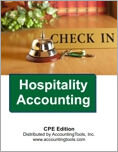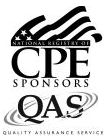Hospitality Accounting (CPE Course)
CPE Credit: 19 hours
Course Type: Downloaded PDF materials with online test
Price (with PDF Textbook): $135
Course Description
This course describes the essential accounting for anyone in the hospitality industry, which includes hotels, restaurants, spas, and similar businesses. It familiarizes the accountant with basic concepts and then addresses the various types of financial statements and the accounting needed to construct them. More detailed accounting topics include payroll, fixed assets, and payables. There are also many managerial accounting topics, such as the construction of a budget, price formulation systems, cost-volume-profit analysis, and cash management. In short, the course prepares the accountant for any accounting issues likely to arise in the hospitality industry.
Author: Steven Bragg
Course Number: AC1083
Table of Contents
Chapter 1. Introduction to Hospitality Accounting
Chapter 2. The System of Accounting
Chapter 3. The Financial Statements
Chapter 4. Receivables and Payables Accounting
Chapter 5. Payroll Accounting
Chapter 6. Inventory Accounting
Chapter 7. Fixed Asset Accounting
Chapter 8. Interest Capitalization
Chapter 9. Debt Accounting
Chapter 10. Income Taxes
Chapter 11. Other Accounting Topics
Chapter 12. Controls
Chapter 13. Pricing Methodologies
Chapter 14. Ratio and Trend Analysis
Chapter 15. Cost Concepts
Chapter 16. Cost-Volume-Profit Analysis
Chapter 17. Operations Budgeting
Chapter 18. Capital Budgeting
Chapter 19. The Lease or Buy Decision
Chapter 20. Cash Management
Chapter 21. Working Capital Management
Learning Objectives
Cite the operating characteristics of the hospitality industry.
Specify the intent of the accounting cycle, the key accounting principles, and the source of the information in the trial balance.
Identify the different types, contents, and formats of the financial statements.
Specify the different types of receivable and payable transactions, and the documents associated with the processing of receivables and payables.
Cite the forms used in the payroll process and the methods for calculating compensation and depositing tax remittances.
State the types of inventory systems and cost layering methods, and describe the calculations used to estimate ending inventory.
Identify the costs included in fixed assets, and the concepts used in the calculation of depreciation.
Identify the types of projects for which interest should be capitalized, and when such capitalization should be terminated.
Specify the items included in interest expense and the loan amortization table.
Recognize the tax reports associated with each type of business entity.
Identify the costs considered to be startup costs, as well as the advantages of selling gift cards to customers.
Define the types of controls, and note the controls that apply to each functional area of a business.
State the types of pricing systems in use in the hospitality industry, as well as the impact of inelastic demand on price setting.
Specify the flaws in the ratios used to analyze the hospitality industry.
Identify the types of costs, as well as the benefits of cost management.
Specify the calculations for contribution margin, breakeven, cost-volume-profit analysis, and sales mix variance.
Recognize the disadvantages of budgeting in general and flexible budgeting in particular, as well as the calculation of the different types of variances.
State the components of the cost of capital, and the types of analysis techniques used in capital budgeting.
Cite the information used to derive a lease rate, as well as the conditions under which it makes the most sense to use different types of leases.
Identify the advantages and disadvantages of a cash concentration system and a notional pooling system, as well as the content of the short-term and medium-term cash forecasts.
Identify the different types of investment strategies.
Specify the composition of the cash conversion cycle, and ways to improve working capital cash flow.
Level: Overview
Instructional Method: QAS Self-Study
NASBA Category: Accounting
Prerequisites: None
Advance Preparation: None
Latest Review Date: January 2024
Program Registration Requirements: Click on "Purchase Course" near the top of this page to pay for and access the course. You will then be able to download the course as a PDF file, then take an on-line examination, and then download a certificate of completion if you pass the examination.
Program Refund Policy: For more information regarding administrative policies concerning complaints, refunds, and other matters, see our policies page.
AccountingTools, Inc. is registered with the National Association of State Boards of Accountancy (NASBA) as a sponsor of continuing professional education on the National Registry of CPE Sponsors. State boards of accountancy have the final authority on the acceptance of individual courses for CPE credit. Complaints regarding registered sponsors may be submitted to the National Registry of CPE Sponsors through its website: www.nasbaregistry.org.
The NASBA sponsor identification number for Accountingtools, Inc. is 115881.
AccountingTools is an IRS Approved Continuing Education Provider. We are compliant with the requirements for continuing education providers (as described in sections 10.6 and 10.9 of the Department of Treasury’s Circular No. 230 and in other IRS guidance, forms, and instructions). Our IRS Approved Continuing Education Provider number is 72821.


